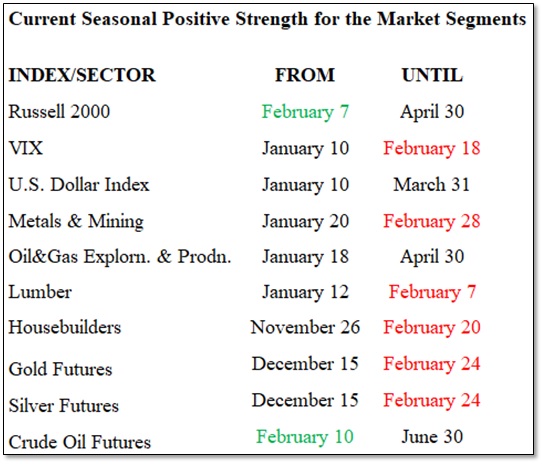eResearch | The year 2021 was an excellent one for stock market investors. We think 2022 will be much more challenging and, if January is any indication, it will be a struggle to come anywhere near the excellent performance generated last year.
We track 12 Canadian sector ETFs and 12 U.S. sector ETFs. (We will start publishing monthly reports on the performance of these ETFs in the not-too-distant future.) In January, there were only THREE Canadian sector ETFs that finished positively for the month: Energy (+17.8%); Financials (+3.7%); and Base Metals (+1.0%). But, there was only ONE U.S. sector ETF that was positive for the month and that was, of course, Energy (+18.8%). All the remainder were negative, some decidedly so.
After a large number of indexes/sectors that entered strong seasonality periods last October, subsequent months have been quite quiet, particularly January and February from a positive seasonality standpoint.
However, March is very active, so we will gear up then. January was brutal for many sectors, particularly Information Technology, whose Canadian ETF was eviscerated to the tune of -12.0%. Its next period of seasonal strength begins on March 18, until July 17.
Conversely, Energy in Canada had a sterling January, up a remarkable 17.8%. Energy’s next strong seasonality period is March 20 – April 28.
We have been calling for a market pull-back for some time, and January may have been it. We will see. In the meanwhile, Investors should approach new investing with caution. For ideas on possible defensive positions, please refer to our Dividend Yield Portfolio report, published monthly. Our January 31, 2022 report can be accessed here: Dividend Yield Portfolio Continues To Perform Well
Changes for February
There are TWO market indexes/sectors that exhibit new seasonal strength in February. These are as follows: Russell 2000 and Crude Oil Futures. See the chart below.
The SIX indexes/sectors that leave their period of seasonality strength behind this month are VIX, Metals & Mining, Lumber, Housebuilders, Gold Futures, and Silver Futures, and also shown in the chart below.
There was only ONE index/sector, which left during the month of January and that was Crude Oil Futures, which exited at the beginning of January. But, it comes back into strength in mid-February.
Seasonal Trends for the Market Segments in February
The following table shows which indexes/sectors gain or lose seasonal strength during the month of February. There are 2 additions this month, shown in GREEN under FROM, and there are 6 expiries this month, shown in RED under UNTIL.
NOTE: A full seasonality list of indexes and sectors is provided at the end of this report.
Figure 1: Current Seasonal Positive Strength for the Market Segments

Importance of Seasonality Trends
Seasonality refers to particular time-frames when stocks/sectors/indexes are subjected to and influenced by recurring tendencies that produce patterns that are apparent in the investment valuation process. A seasonality study preferably uses at least 10 years of data.
Seasonality Trends Chart
The Seasonality Trends chart below was updated in December 2021. The chart shows the periods of seasonal strength for 41 market segments (sectors/indexes). Each bar indicates a buy and a sell date (start/end dates) based upon the optimal holding period for each market sector/index. Our update involved only a few minor tweaks to the start/end dates.
The Seasonality Trends chart is an ever-changing 14-year average of the indexes and sub-indexes that we track. The information in the chart is courtesy of www.equityclock.com.
Figure 2: Seasonality Trends Chart

Notes: All numbers in CAD unless otherwise stated. The author of this report, and employees, consultants, and family of eResearch may own stock positions in companies mentioned in this article and may have been paid by a company mentioned in the article or research report. eResearch offers no representations or warranties that any of the information contained in this article is accurate or complete. Articles on eresearch.com are provided for general informational purposes only and do not constitute financial, investment, tax, legal, or accounting advice nor does it constitute an offer or solicitation to buy or sell any securities referred to. Individual circumstances and current events are critical to sound investment planning; anyone wishing to act on this information should consult with a financial advisor. The article may contain “forward-looking statements” within the meaning of applicable securities legislation. Forward-looking statements are based on the opinions and assumptions of the Company’s management as of the date made. They are inherently susceptible to uncertainty and other factors that could cause actual events/results to differ materially from these forward-looking statements. Additional risks and uncertainties, including those that the Company does not know about now or that it currently deems immaterial, may also adversely affect the Company’s business or any investment therein. Any projections given are principally intended for use as objectives and are not intended, and should not be taken, as assurances that the projected results will be obtained by the Company. The assumptions used may not prove to be accurate and a potential decline in the Company’s financial condition or results of operations may negatively impact the value of its securities. Please read eResearch’s full disclaimer.



